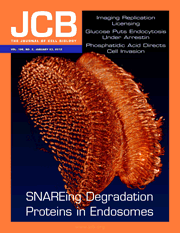The synaptic vesicle SNARE neuronal Synaptobrevin promotes endolysosomal degradation and prevents neurodegeneration in Drosophila.
Haberman, A.S., Williamson, W.R., Epstein, D., Wang, D., Rina, S., Meinertzhagen, I.A. and Hiesinger, P.R. – 2012
Soluble NSF attachment protein receptors (SNAREs) are the core proteins in membrane fusion. The neuron-specific synaptic v-SNARE n-syb (neuronal Synaptobrevin) plays a key role during synaptic vesicle exocytosis. In this paper, we report that loss of n-syb caused slow neurodegeneration independent of its role in neurotransmitter release in adult Drosophila melanogaster photoreceptor neurons. In addition to synaptic vesicles, n-Syb localized to endosomal vesicles. Loss of n-syb lead to endosomal accumulations, transmembrane protein degradation defects, and a secondary increase in autophagy. Our evidence suggests a primary defect of impaired delivery of vesicles that contain degradation proteins, including the acidification-activated Cathepsin proteases and the neuron-specific proton pump and V0 adenosine triphosphatase component V100. Overexpressing V100 partially rescued n-syb–dependent degeneration through an acidification-independent endosomal sorting mechanism. Collectively, these findings reveal a role for n-Syb in a neuron-specific sort-and-degrade mechanism that protects neurons from degeneration. Our findings further shed light on which intraneuronal compartments exhibit increased or decreased neurotoxicity.

